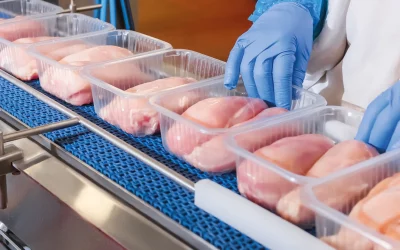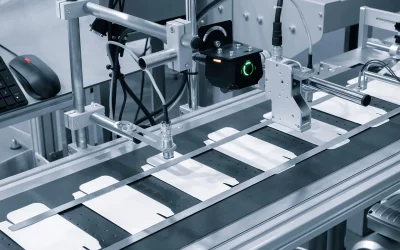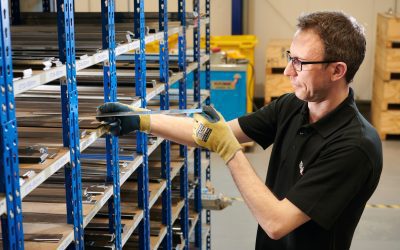Why knife sharpness matters
The sharpness of your machine blades may not seem all that important when you consider your meat processing operation as a whole.
But, the contrary is true!
Machine blade sharpness is a factor which can have a cascading effect on the efficiency of your whole operation.
Industrial machine blades need to be able to retain their sharpness in order to provide accurate cuts time after time. If your machine blades are unable to deliver the required cuts, you’ll quickly find that you’ll have spoiled cuts of meat, a bottleneck in your operations, and costly downtime as a result.
To give you an idea of how tough cutting meat can be on blades, consider that beef processing machinery can require up to six freshly sharpened knives per day.
The benefits of maintaining knife sharpness
Knife sharpness is critical. But, what are the tangible benefits? They can be summarised as followers:
- Faster processing – the faster you can process meat, the better your profit margins are going to be. In other words, you’ll need less time per cut, boosting productivity.
- Increased quality – sharper blades will lead to much more attractive, higher-quality cuts of meat that will have a higher retail value.
- Increased yield – with consistently sharp blades, you’ll experience less wastage, leading to a higher overall yield of sellable cuts of meat.
What you need to know about knife sharpness
As we have seen, sharpness is essential. But, what exactly is it? What does the ‘term’ sharpness refer to? Let’s take a look…
Sharpening a knife is in fact a process, which includes several distinct steps.
Grinding
Grinding refers to the process of removing metal from behind the cutting edge. This process aims to shape the blade’s overall cross-section and reveal the cutting edge of the blade.
There are in fact many types of ‘grinds’ which can be applied to blades. These grinds include:
- Asymmetrical grind.
- Chisel grind.
- Compound grind.
- Convex grind.
- Flat grind.
- High flat grind.
- Hollow grind.
- V-grind.
Each type of grind lends itself to a particular application or use case.
Note – well-maintained blades need grinding less often than neglected/poorly maintained blades.
Honing
Once a blade has been ground, it will be sharp. However, the cutting edge will generally be out of alignment.
That’s where honing steps in. Honing aims to ‘centre’ the cutting edge of the blade and is sometimes also known as ‘folding back the burr’. Honing is typically carried out using honing steels (also known as honing rods).
Failure to hone your knives on a regular basis can lead to the dulling of your knives. Over a long enough timeline, failure to hone your knives can result in them needing to be reground.
Polishing
The next step in the overall knife sharpening process is polishing. At this stage, the blade will be sharp, and its cutting edge will have been honed and centred.
Polishing a knife helps to deburr and smooth the final cutting edge of the knife. In fact, this polishing process is more important than many people realise. An effectively well-sharpened knife can be razor sharp.
In other words – if you want your machine blades to offer razor sharp cuts – make sure you choose a regrinding service that puts as much focus on the polishing stage as it does the grinding and honing stages.
Inspection
The final stage of the knife sharpening process is inspection. A good knife grinding service will use experienced specialists to inspect the blade once it has been through the sharpening process.
Significant characteristics such as the blade’s cross-section, profile, and cutting edge will be closely checked to ensure they are of the required standard.
Knife sharpening best practices
Now that we’ve seen the various steps that are involved in the knife sharpening process, let’s take a look at the best practices which can help you maintain the sharpness of your blades and knives.
Buy the best quality blades
If you want blades that are going to maintain their sharpness for longer, then you’re going to have to buy blades that are designed and manufactured from the very best materials.
Here at MRMK, our machine blades are designed by experienced engineers who have in-depth knowledge of metallurgy, blade design and use – and an insight into the meat processing industry.
Our blades are manufactured here in the UK, in the heart of the global steel industry – Sheffield.
What’s more, our machine blades for meat processing are manufactured to OEM (or higher) standards, but at a fraction of the cost. In short – MRMK should be your number one destination for new machine blades!
Regular inspections
As we saw earlier, cutting meats can be a particularly aggressive task for machine blades to deal with every day.
Therefore, you should ensure you are inspecting your blades every day – potentially even multiple times per day. This will highlight any dulling of the blades, allowing them to be sent for regrinding before they deteriorate further.
Inspections should also check things like cutting angles and machine fit, to ensure the blades aren’t configured in such a way that will cause them todull unnecessarily quickly.
Regular cleaning
Although the best machine blades are made from food-grade stainless steel, they can still be subject to corrosion and dulling if they are not cleaned on a regular basis.
We’d suggest establishing a thorough cleaning regime for your blades. This can be done alongside your regular inspections, combining the two tasks into one.
Looking for new meat processing blades?
Then you’re looking in the right place. MRMK produces industrial machine blades for meat processors the world over.
With 800+ happy customers in more than 50 countries, MRMK is the blade manufacturer of choice for the global meat processing industry.
Explore MRMK’s machine knives for meat processing now
For more machine blade buying guides, advice and information, read the MRMK News and Insights Hub…
What Are the Best Industrial Blades for Meat Processing Operations? | 7 Food Industry Trends to Watch in 2022 | Top 5 Things to Consider When Choosing Machine Knives and Blades for the Food Processing Industry


 +44 (0) 1909 519815
+44 (0) 1909 519815 


